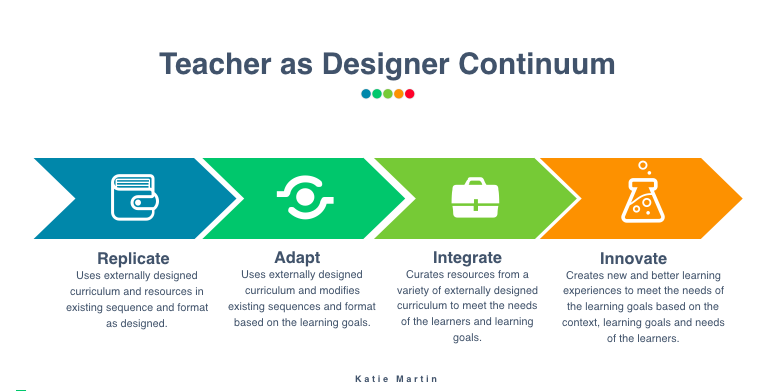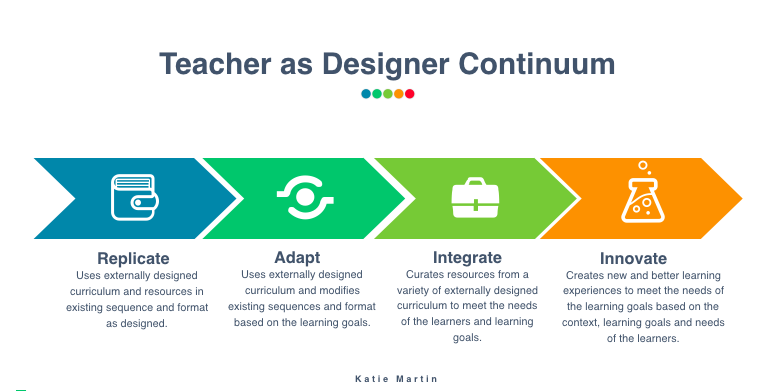Traditionally, the curriculum has been organized in a linear path that promotes a one size fits all approach to success. When teachers are expected to follow directives or implement programs without taking the context and unique individuals in their room into consideration, it often creates frustration because they see their students need something else, something different, but don’t feel they have the authority to make those changes. Often, the focus on compliance and covering content, rather than learning further drives the cover, cram, assess and reteach mentality. This model has left far too many behind and even many who have successfully navigated school remain ill-prepared for the world we live in.
If we need people to think differently, solve problems, and be prepared for jobs that don’t exist, how can we structure learning experiences with the curriculum that is linear and standardized?
Many districts are beginning to challenge the notion that the textbook or the scope and sequence is the “right” way to teach and with changing standards and learning expectations, more districts have opted not to purchase new textbooks. There is great potential to use Open Educational Resources (OER) to ensure the resources we use to teach continue to evolve with the world in real time.
Empowering Teachers as Designers
I wholeheartedly believe we need to recognize the innovative capacity of all educators to move forward in education. Empowering teachers as designers is critical but it can be overwhelming too. When I talk to teachers in districts that are replacing static textbooks with open education resources, the major challenges that they share include the following:
- Many teachers who have been teaching with prescribed curriculum have little to no preparation for curating and designing learning experiences.
- With much more flexibility and access to content, teachers struggle to evaluate content for alignment to standards and are not sure where to begin to look for quality resources.
- Without clear parameters, many feel uncertain about where the have flexibility to be innovative and where they don’t.
- In lieu of these guidelines, resources and time, teachers can revert back to old textbooks and teaching methods.
Teachers often express the desire to have clear expectations but autonomy to meet the needs of their students in a way that works for them. Too much structure is stifling but too little can be just as crippling. Leaders are crucial in setting the culture and tone of how teachers learn and take risks in their practice. Creating the foundation and empowering teachers to take risks can allow for better practices to emerge as they learn, iterate, and invent new practices based on the needs of the learners.
Teacher as Designer Continuum
In Scaling up Excellence, Bob Sutton and Huggy Rao describe the continuum that plays a critical role in scaling efforts in diverse organizations. On one end, expectations allow for local, customized decisions. On the other end, expectations lean toward increased standardization and replication. The authors describe the role of leaders: “managing the tension between replicating tried-and-true practices and modifying them (or inventing new ones) to fit local conditions weighs on decision makers, shapes key events, and leads to success or failure.”
Creating the high-quality foundation to build from is critical to supporting teachers in this important work. In my book, Learner-Centered Innovation, I describe how resources and frameworks allow for creativity and innovation when they provide the foundation—not the ceiling—for what teachers can build on, adapt, and innovate. Based on the context, the resources, and the desired learning goals, teachers can leverage foundational resources across the following continuum to meet the needs of the learners:
-
Replicate—Uses externally designed curriculum and resource in existing sequence and format as designed
-
Adapt—Uses externally designed curriculum and modifies existing sequences and format based on the learning goals
-
Integrate—Curates resources from a variety of sources to meet the needs of the learners and learning goals
-
Innovate—Creates new and better learning experiences based on the context, learning goals, and needs of the learners.

As I reflect on my own experiences and the countless educators I have observed and worked with, it is clear that the best teachers do not use a single approach or follow one curriculum; they create the context and experiences for diverse students to learn and grow. If we can provide high-quality learning experiences that teachers can replicate, this should be the foundation that educators can build from. To meet the needs of learners and innovate in their classroom, collaboration, resources, and coaching can and should be built into the workday to support teachers to move across the continuum.



What continuously brings me back to learning along side you Katie is your rich understanding for the fundamentals to learning. The countless times you speak to diversity in learning not only for students, but for educators as well. From the bottom up… building a foundation that is created beyond one resource. Thank you for always shining a light on “one size does not fit all!”
Thank you, Kristen! Appreciate all you do to create amazing experiences for all kids:)